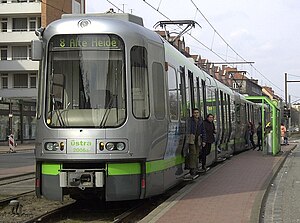History
After winning the bid for the Expo 2000 in 1990, the city of Hanover faced the need to greatly improve its transportation system. Therefore, the autobahn system was brought up to better standards, new buses were ordered (the StadtBus), and it was decided to buy new light rail vehicles for the Hanover Stadtbahn. Whilst a ninth series of the TW 6000, the Stadtbahn vehicle built from 1974 to 1993, could have technically been produced, the Hanover public transport operator üstra decided to build a new vehicle from scratch, using up-to-date technology, without the necessity to make the vehicle compatible to the aged design of the TW 6000.
The car was designed by Herbert Lindinger with British designer Jasper Morrison and was manufactured from 1997 to 2000 by Linke-Hofmann-Busch in Salzgitter (now part of Alstom).
The first car delivered was 2002, which was delivered to the Döhren depot on April 12, 1997. 2001, the first of the series, was delivered the following day to the Hanover fairground to serve as a showcase at Hannover Messe. The official presentation to the general public was on April 27, 1997, at Döhren depot, the cars went into official operational use on route 8 by September 1, 1997.
A notable feature is a system of several monitor pairs mounted under the ceiling. While the left monitor displays the next four stops, the right one provides news and adverts.
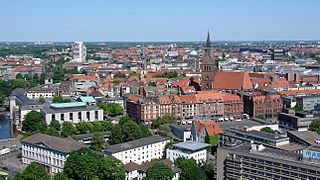
Hanover is the capital and largest city of the German state of Lower Saxony. Its 534,049 (2020) inhabitants make it the 13th-largest city in Germany as well as the third-largest city in Northern Germany after Hamburg and Bremen. Hanover's urban area comprises the towns of Garbsen, Langenhagen and Laatzen and has a population of about 791,000 (2018). The Hanover Region has approximately 1.16 million inhabitants (2019).

The Chevrolet Silverado is a range of trucks manufactured by General Motors under the Chevrolet brand. Introduced for the 1999 model year, the Silverado is the successor to the long-running Chevrolet C/K model line. Taking its name from the top trim level from the Chevrolet C/K series, the Silverado is offered as a series of full-size pickup trucks, chassis cab trucks, and medium-duty trucks. The fourth generation of the model line was introduced for the 2019 model year.

Stadtbahn is a German word referring to various types of rail transport. One type of transport originated in the 19th century, firstly in Berlin and followed by Vienna, where rail routes were created that could be used independently from other traffic.

The Frankfurt U-Bahn is a Stadtbahn system serving Frankfurt, Hesse, Germany. Together with the Rhine-Main S-Bahn and the Frankfurt Straßenbahn, it forms the backbone of the public transport system in Frankfurt. Its name derives from the German term for underground, Untergrundbahn. Since 1996, the U-Bahn has been owned and operated by Stadtwerke Verkehrsgesellschaft Frankfurt am Main (VGF), the public transport company of Frankfurt, and is part of the Rhein-Main-Verkehrsverbund (RMV) transport association. The licence contract is up to 31 December 2031 and is renewable. The contracting authority of VGF is the municipal transport company traffiQ.

Volkswagen Commercial Vehicles is a German marque of light commercial vehicles, owned by Volkswagen Group. It is headquartered in Hannover, Lower Saxony, Germany. Originally part of Volkswagen Passenger Cars, it has operated as a separate marque since 1995.
The Hanover Fairground is an exhibition area in the Mittelfeld district of Hanover, Germany. Featuring 496,000 m² of covered indoor space, 58,000 m² of open-air space, 27 halls and pavilions and a convention centre with 35 function rooms, it is the largest exhibition ground in the world.

Hannover Hauptbahnhof is the main railway station for the city of Hanover in Lower Saxony, Germany. The railway junction is one of the 21 stations listed as a railway Category 1 station by DB Station&Service. It is also the most important public transport hub of the region of Hanover and it is served regional and S-Bahn services. The station has six platforms with twelve platform tracks, and two through tracks without platforms. Every day it is used by 250,000 passengers and 622 trains stop at the platforms. About 2,000 people work here.

The TW 6000 is a type of articulated light rail vehicle used on the Hanover Stadtbahn system, manufactured by Duewag, Linke-Hofmann-Busch, AEG, Kiepe and Siemens.

The Hanover Stadtbahn is a Stadtbahn system in the city of Hanover, Lower Saxony, Germany. The Stadtbahn opened on 29 September 1975, gradually replacing the city's tramway network over the course of the following 25 years. Currently, the Hanover Stadtbahn system consists of 12 main lines, serving 196 stations, and operating on 121 kilometres (75 mi) of route. The system is run by üstra, which was originally an abbreviation for Überlandwerke und Straßenbahnen Hannover AG. As of 2007, it transported 125 million passengers per year.

The Hanover S-Bahn is an S-Bahn network operated by DB Regio and Transdev Hannover in the area of Hanover in the German state capital of Lower Saxony. It went operational shortly before Expo 2000 and is focused on the Hanover region, and also connects with adjacent districts, and into the state of North Rhine-Westphalia. The S-Bahn is an evolution of a suburban railway.

The TW 400 is a type of tram vehicle formerly used on the tramways of Hanover, Germany, built from 1956 to 1958 by Duewag. Some units underwent remodeling to prepare them for being used on the Hanover Stadtbahn network but they were never used for this purpose.
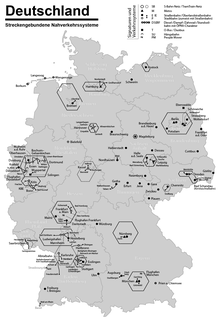
Germany has an extensive number of tramway networks. Some of these networks have been upgraded to light rail standards, called Stadtbahn in German. Straßenbahn and Stadtbahn schemes are usually operated on the legal foundation of the BOStrab, the Tramways Act of Germany.
Leipziger Verkehrsbetriebe GmbH operates one of Germany's largest tramway networks. The tramway network history is presented below in tabular form, including opening, electrification, and closing dates by segment. Street names of the time are used in the tables, with current names in (parentheses).

The Tram 2000 is a type of tram vehicle that was originally designed for the Verkehrsbetriebe Zürich (VBZ), the municipal transport operator of the Swiss city of Zürich, and first introduced in 1976. Other variants of the type were subsequently built for the VBZ, for other Swiss operators, and for the Italian city of Genoa. The last vehicles to the design entered service in 1994, but the type is still in front line service with all its original users.

Hannover Messe/Laatzen station is a Category 4 station in the German town of Laatzen near the Hanover fairground. It is normally served only by the Hanover S-Bahn. During major events such as CeBIT and Hanover Messe, all passing regional and long distance trains stop at the station. The station opened in 2000, replacing the old Messe station, which was located on a spur line in the fairgrounds.

The Freiburg im Breisgau tramway network is a network of tramways that forms part of the public transport system in Freiburg im Breisgau, a city in the federal state of Baden-Württemberg, Germany. Established in 1901, the network has been operated since its foundation by the company now known as Freiburger Verkehrs, and powered by electricity. The tramway network currently has five lines. The expansion of the tram network since 1980 has served as an example of the "renaissance of the trams" in Germany. As of 2021, 76 trams were available for regular use: 5 of these were high-floored, 36 partial and 35 low-floored. Almost the entirety of the network is located within Freiburg's urban area; only a few metres of the balloon loop at Gundelfinger Straße are located outside the boundary of Gundelfingen to the north of Freiburg. In total, the trams serve 20 out of the 28 districts in Freiburg.

The Essen Stadtbahn is a 19.6-kilometer (12.2 mi) light rail (Stadtbahn) network in Essen and the two neighbouring towns of Mülheim an der Ruhr and Gelsenkirchen in the German state of North Rhine Westphalia. It forms part of the Rhine-Ruhr Stadtbahn.

The Erfurt Stadtbahn is a light rail network that is the basic public transit system of Erfurt, the capital of Thuringia in Germany. It represents the evolution of the city's original tramway which, outside of the city center, travels on track in its own right-of-way. The meter gauge network is made up of six lines, and has a total route length of 45.2 kilometers (28.1 mi), making it one of Germany's more moderate-sized Stadtbahn networks. The network is run by Stadtwerken Erfurter Verkehrsbetriebe AG, and is integrated in the Verkehrsverbund Mittelthüringen (VMT). The Stadtbahn carried 41.933 million passengers in 2012, which corresponds to about 114,885 passengers per day.
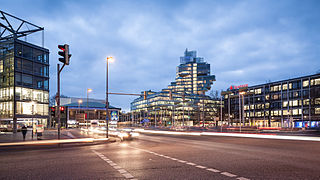
The Aegidientorplatz, colloquially known as Aegi is a busy square in Hanover located above the U-bahn station of the same name. The square was named for the Aegidientor, one of the city gates of Medieval Hanover, which existed until 1780.
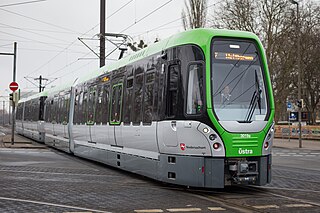
The TW 3000 is a type of articulated light rail vehicle used on the Hanover Stadtbahn system since 2015. The trains are built by a consortium of Vossloh Kiepe and Alstom, with the final assembly taking place at HeiterBlicks Leipzig factory.
